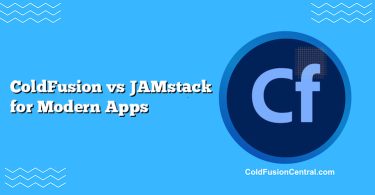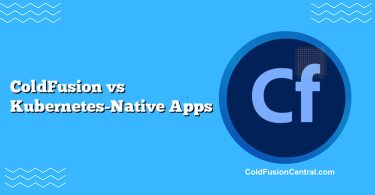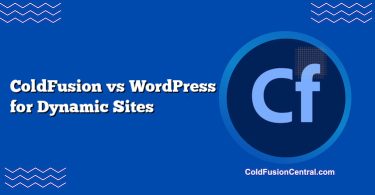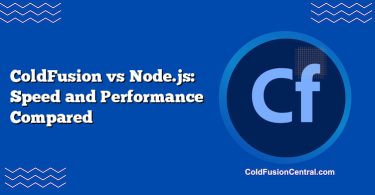ColdFusion vs Spring Boot (Java)
Definitions
-
ColdFusion: A commercial, JVM-based web application platform from Adobe (with open-source CFML engines like Lucee). It uses the CFML language to enable rapid application development with tag-based and script syntax, offering extensive built-in services for database access, caching, PDF generation, email, image manipulation, and REST endpoints.
-
Spring Boot (Java): An open-source framework built on the Spring ecosystem that simplifies building production-grade Java applications and microservices. It provides auto-configuration, opinionated defaults, embedded servers (Tomcat/Jetty/Undertow), and deep integrations with Spring Security, Spring Data, and cloud-native tooling.
Overview
Both ColdFusion and Spring Boot target server-side web development on the JVM, but they serve different priorities:
- ColdFusion emphasizes rapid application development (RAD), low ceremony, and quick delivery of data-driven web apps—especially in teams where developers may not be deep Java experts.
- Spring Boot emphasizes structured engineering, microservices, high scalability, strong typing, and a vast Java ecosystem, making it ideal for large-scale, cloud-native systems.
Key Features
ColdFusion Highlights
- CFML with tag/script options for fast server pages and services.
- Built-in features: ORM (Hibernate), PDF, email, charting, image processing, scheduled tasks, web sockets, REST endpoints, caching.
- Admin console for data sources, caches, mail servers, and security settings.
- Integration: Calls into Java libraries; deploys on the JVM.
- Adobe support and commercial SLAs; alternative engine: Lucee (open-source).
Spring Boot Highlights
- Auto-configuration and starter dependencies for quick setup.
- Embedded servers (Tomcat/Jetty/Undertow) for easy deployment as a fat JAR.
- Spring ecosystem: Spring Data, Spring Security, Spring Cloud, Spring WebFlux, Actuator, Micrometer.
- Cloud-native patterns: config servers, service discovery, circuit breakers (via Spring Cloud), Kubernetes/Docker best practices.
- Observability: Metrics, health checks, tracing integrations.
Performance
ColdFusion
- Suitable for CRUD-heavy business apps, internal portals, and content-driven sites with moderate concurrency.
- Performance bottlenecks can arise when doing CPU-intensive workloads or very high throughput microservices.
- Tuning involves JVM settings, caching, connection pooling, and template compilation.
Spring Boot
- High throughput and low latency when engineered with proper async/reactive stacks (Spring WebFlux), connection pooling, and JVM tuning.
- Designed for microservices and horizontally scalable architectures.
- Fine-grained control over threads, GC, memory footprint; broad optimization resources and community guidance.
Scalability
ColdFusion
- Vertical scaling works well; horizontal scaling supported via clustering (Enterprise edition) and session replication.
- Typically best for medium-scale workloads, intranets, departmental applications, and monoliths that can later be split.
Spring Boot
- Built for horizontal scaling and distributed systems. Plays well with Docker/Kubernetes, service meshes, and cloud gateways.
- Ideal for microservices architectures with independent lifecycle and CI/CD pipelines.
Security
ColdFusion
- Provides secure session handling, built-in protections (CSRF tokens, input validation tags), and hardened admin features.
- Regular Adobe security updates; smaller ecosystem than Java so fewer third-party library risks, but updates depend on licensing/version.
- Security posture improves with disciplined config and patch cadence.
Spring Boot
- Spring Security is a major strength: authentication/authorization, OAuth2/OIDC, SAML, method-level security, RBAC, and policy-as-code.
- Mature dependency management and security scanning (e.g., Maven/Gradle + OWASP/Dependabot).
- Strong observability and audit via Actuator and logging/tracing frameworks.
Cost
ColdFusion
- Commercial licensing (per core) for Adobe ColdFusion; can be significant for production with many CPUs/containers.
- Lucee is a popular, open-source CFML alternative that reduces licensing cost but may require community-based support.
- Lower developer onboarding time can translate into lower development cost for simple apps.
Spring Boot
- Free and open-source. No runtime licensing cost.
- Development may require more Java expertise; productivity depends on team skill and existing DevOps maturity.
- Excellent fit for cost-efficient scaling in the cloud due to microservice alignment and container-first deployment.
Community Support
ColdFusion
- Smaller, focused community; Adobe Support and long-term support releases.
- Ecosystem of CFML packages, though less extensive than Java.
- Lucee community provides OSS forums and plugins.
Spring Boot
- One of the largest developer communities in the JVM world.
- Rich learning resources, tutorials, Stack Overflow presence, conferences, and vendor support from multiple companies.
- Wide availability of specialized libraries and integrations.
Side-by-Side Comparison
| Dimension | ColdFusion (Adobe CF / CFML) | Spring Boot (Java) |
|---|---|---|
| Performance | Good for typical CRUD apps; moderate scale | Excellent for high-throughput, low-latency microservices |
| Scalability | Vertical + clustering (Enterprise) | Horizontal-first; cloud-native; Kubernetes/Docker friendly |
| Cost | Commercial licensing (Adobe) or free (Lucee) | Free/open-source; infra and dev time are main costs |
| Productivity | Very high for rapid development | High once project setup; more ceremony than CF for UI pages |
| Security | Solid built-in features; vendor patches | Best-in-class via Spring Security and ecosystem |
| Ecosystem | Niche, smaller marketplace | Vast Java ecosystem, libraries, and tooling |
| Use Cases | Internal apps, portals, content-driven sites | Microservices, APIs, large enterprise systems |
| Pros | Fast to build, rich built-ins, easy CFML | Scalability, performance, security, cloud-native |
| Cons | Licensing costs, smaller community | Steeper learning curve, more boilerplate for some tasks |
| Deployment | JVM app server; supports clustering | Fat JAR/Native image; containers; CI/CD friendly |
Real-World Scenarios
When ColdFusion Shines
- A mid-size marketing department needs a secure internal portal to manage campaigns, upload assets, generate PDFs, and email reports. A small team can deliver features quickly with CFML tags, scheduled tasks, and built-in PDF/email. The result: fast time-to-value, minimal boilerplate, and simplified maintenance by non-Java specialists.
When Spring Boot Shines
- A fintech platform needs to process thousands of transactions per second across multiple services (payments, risk scoring, ledger, notifications). Spring Boot microservices with Spring Cloud, Kafka, Spring Security, Actuator, and Kubernetes orchestration provide resilience, observability, scalability, and compliance capabilities.
Step-by-Step Decision Insights
-
Define your primary goal:
- If you need rapid delivery of form-based pages, reports, and REST endpoints with minimal ceremony, consider ColdFusion.
- If you need distributed microservices, cloud-native deployments, and strict SLOs, consider Spring Boot.
-
Evaluate team expertise:
- Limited Java experience and small team: ColdFusion reduces complexity.
- Strong Java experience and DevOps maturity: Spring Boot accelerates at scale.
-
Project lifespan and growth:
- Short-to-medium term, departmental app: ColdFusion is pragmatic.
- Long-term, evolving platform: Spring Boot’s ecosystem and modularity pay off.
-
Budget and licensing:
- If licensing is a constraint, prefer Spring Boot or Lucee.
- If official vendor support and commercial SLAs matter, Adobe ColdFusion is compelling.
-
Compliance and security:
- For complex auth flows (OAuth2/OIDC, SAML), Spring Security is often the fastest route.
- For simpler needs, ColdFusion’s built-ins may suffice with proper hardening.
Supported Platforms and Deployment
-
ColdFusion:
- Platforms: Windows, Linux, and JVM-compatible environments.
- Deployment: Application server with Admin console, WAR deployment options; clustering in Enterprise edition.
- Containers: Supported; licensing implications per core/container.
-
Spring Boot:
- Platforms: Any JVM-supported OS (Windows, Linux, macOS).
- Deployment: Fat JAR, WAR (if needed), containers (Docker), Kubernetes.
- Cloud-native: Integrates with config servers, service discovery, service meshes.
Language and Syntax Differences (High-Level)
| Aspect | ColdFusion (CFML) | Spring Boot (Java) |
|---|---|---|
| Style | Tag-based and script syntax | Strongly typed Java with annotations |
| Learning Curve | Gentle for web devs, quick results | Moderate to steep; requires Java proficiency |
| Built-in Features | Many features in the platform | Lean core; add via Spring starters/libraries |
| Testing | CFML testing libs exist | JUnit/Jupiter, Spring Test, MockMVC |
| Configuration | Admin console + config files | application.properties/yaml + profiles |
Pros and Cons
ColdFusion Pros
- Rapid application development and low ceremony.
- Rich built-ins reduce dependency hunting and boilerplate.
- Integrated admin console simplifies ops for small teams.
- Easy onboarding for non-Java specialists.
ColdFusion Cons
- Licensing costs (Adobe) and smaller community.
- Less ideal for high-throughput microservices.
- Fewer modern cloud-native patterns out of the box compared to Spring Boot.
Spring Boot Pros
- Outstanding scalability and performance potential.
- Spring Security, Spring Data, Spring Cloud provide enterprise-grade capabilities.
- Massive ecosystem and community support.
- Excellent fit for Docker/Kubernetes and DevOps pipelines.
Spring Boot Cons
- Steeper learning curve for teams new to Java/Spring.
- More moving parts; initial complexity higher than CF for simple apps.
- Productivity depends on team familiarity and project scaffolding.
Decision Factors / Which One Should You Choose?
-
Choose ColdFusion if:
- You need a departmental app or internal portal fast.
- Your team is small, mixed-skill, or prefers CFML and a GUI-driven admin.
- You value built-in features (PDF, email, scheduled tasks) without stitching multiple libraries.
- You can justify Adobe licensing or opt for Lucee with community support.
-
Choose Spring Boot if:
- You’re building APIs/microservices with high availability and horizontal scaling.
- You want strong security, observability, and cloud-native features.
- Your team has Java/Spring expertise and plans for long-term platform evolution.
- You prioritize open-source, vendor neutrality, and a large ecosystem.
Pro tip: You can also combine them. For example, a ColdFusion front-end for rapid content and forms, backed by Spring Boot microservices for heavy computation and scale-out APIs.
Key Takeaways / Summary Points
- ColdFusion excels at rapid delivery of business applications with many built-in services, ideal for small teams and moderate scale.
- Spring Boot is the go-to for cloud-native, microservice architectures requiring strong security, observability, and scalability.
- Budget, team skillset, and long-term roadmap should guide your choice more than raw feature lists.
- Consider Lucee as an open-source CFML option to reduce licensing cost, and use Spring Boot when you need large-scale, distributed systems engineering.
FAQ
Is ColdFusion still relevant for new projects?
Yes, especially for teams that want rapid delivery of internal or content-driven applications. CFML’s built-in features and Adobe’s support make it viable. For licensing-sensitive environments, Lucee (open-source CFML) is an option.
Can I run both ColdFusion and Spring Boot together?
Yes. You can build Spring Boot microservices for scalable APIs and use ColdFusion for quick admin consoles, report generation, or content tools, communicating over REST/GraphQL.
Which is better for DevOps and containers?
Spring Boot. It integrates seamlessly with Docker, Kubernetes, service meshes, and CI/CD pipelines. ColdFusion can be containerized, but Spring’s ecosystem is more mature for cloud-native patterns.
How do maintenance and hiring compare?
Spring Boot benefits from a larger Java talent pool and ecosystem. ColdFusion teams can be highly productive, but the talent pool is smaller; however, this can be offset by faster RAD and simpler operations for certain workloads.




